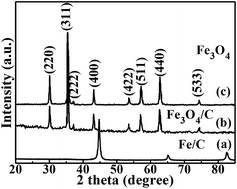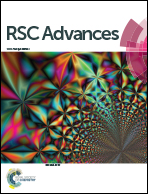Improved electrochemical performance of onion-like carbon coated magnetite nanocapsules as electromagnetic absorptive anode materials for lithium-ion batteries
Abstract
The synthesis of magnetite (Fe3O4)@C nanocapsules with Fe3O4 nanoparticles as the core and onion-like carbon as the shell has been reported. The electromagnetic (EM) characteristics and electrochemical performance are studied. The onion-like carbon shell improves dielectric loss and EM matching degree, leading to enhanced EM properties. The optimal reflection loss (RL) value of the Fe3O4@C–paraffin composite is −45.9 dB at 16.6 GHz at a thickness of 2.4 mm and the absorption bandwidth of 7.2 GHz (RL exceeding −10 dB) covers 9.8–17.0 GHz at 3.0 mm. The EM absorption mechanism may be explained by the combination of the EM loss model and the quarter-wavelength cancellation condition. The onion-like defective carbon shell not only can accommodate the volume change of Fe3O4 nanoparticles but also can prevent the formation of solid electrolyte interface films on the surface of nanoparticles, resulting in the remarkable electrochemical performance for lithium ion batteries (LIBs). The Fe3O4@C nanocapsules display an attractive cycling performance up to 300 cycles (918 mA h g−1 retained at 0.1 A g−1) and a high initial coulomb efficiency of 85.6%. A capacity of 934 mA h g−1 is recoverable after the charge–discharge process at high rates. The present work presents Fe3O4@C nanocapsules as a new kind of EM absorptive anode material for LIBs.


 Please wait while we load your content...
Please wait while we load your content...